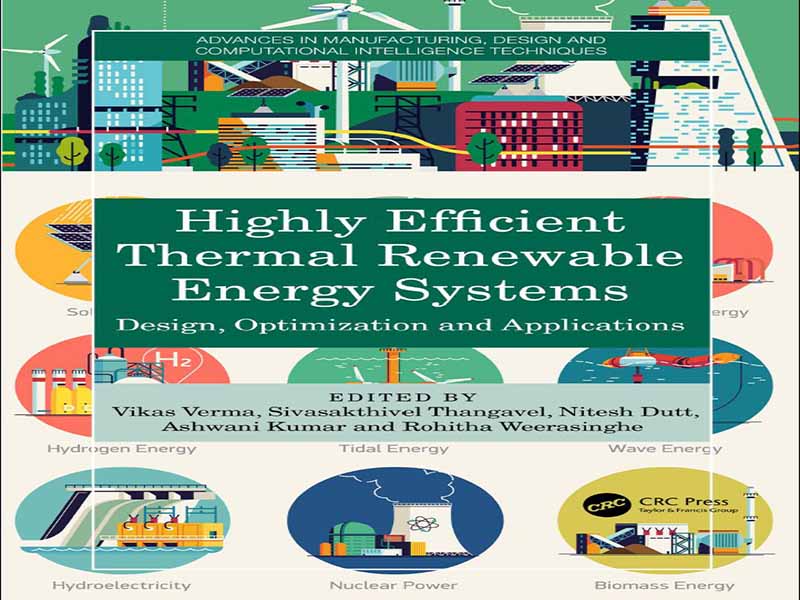- عنوان کتاب: Highly Efficient Thermal Renewable Energy Systems
- نویسنده: Dr. Vikas Verma
- حوزه: انرژی تجدید پذیر
- سال انتشار: 2024
- تعداد صفحه: 377
- زبان اصلی: انگلیسی
- نوع فایل: pdf
- حجم فایل: 13.0 مگابایت
کتاب سیستمهای انرژی تجدیدپذیر حرارتی بسیار کارآمد: طراحی، بهینهسازی و کاربردها دارای 20 فصل است که از پتانسیل سیستمهای تولید انرژی گرفته تا فناوریهای فناوری تعامل انرژی جهانی و اینترنت اشیا را پوشش میدهد. همچنین، این کتاب شامل نقش و ادغام فناوریهای انرژی خورشیدی، زمین زمین و انرژی هیدروژن برای کاربردهای مختلف صنعتی است. علاوه بر این، این کتاب مدلسازی و بهینهسازی سیستمهای انرژی تجدیدپذیر هیبریدی را برای بهبود عملکرد انرژی پوشش میدهد. علاوه بر این، آنالیز نظری، تحلیل اکسرژی، پیادهسازی سیستم هیبریدی مبتنی بر انرژیهای تجدیدپذیر، سیستمهای ذخیره انرژی (ESS) و کاربردهای آنها را نیز شرح داد. فصل 1 سیستم های انرژی خورشیدی، زمین گرمایی و هیدروژن را برجسته می کند. این یک مقدمه کوتاه، پیشرفت های اخیر و جهت گیری های آینده در بخش انرژی را ارائه می دهد. فصل 2 به پیشرفت های فناوری در سیستم های انرژی خورشیدی پایدار و تجدید پذیر می پردازد. پتانسیل انرژی خورشیدی در همه جا بودن و سازگاری با محیط زیست آن نهفته است. زمین به دلیل شرایط جوی و عوامل جغرافیایی مقادیر مختلفی از تابش خورشیدی را دریافت می کند که می تواند برای برآوردن نیازهای انرژی مورد استفاده قرار گیرد. پنل های خورشیدی را می توان بر روی سطوح دریا، پشت بام های ساحلی و مراکز تجاری نصب کرد و مزایای چندوجهی از جمله کاهش رطوبت و پشتیبانی از تصفیه آب را ارائه می دهد. فصل 3 کاوشی روشنگر در قلمرو ذخیرهسازی انرژی حرارتی (TES) ارائه میکند. این روش به مجموعهای از تکنیکهای TES میپردازد و مواد مورد استفاده را همراه با کاربردهای منحصربهفرد آنها که به افزایش بهرهوری انرژی کمک میکنند، روشن میکند. از طریق پذیرش TES، آینده انرژی ما می تواند پایدارتر و انعطاف پذیرتر شود. در ادامه، فصل چهارم به بررسی پذیرش و اجرای انرژی خورشیدی در کشورهای توسعه نیافته می پردازد و هم پتانسیل ها و هم موانع را ارائه می دهد. انرژی خورشیدی نوعی انرژی پایدار و از نظر زیست محیطی بی خطر است که ممکن است به این مناطق در دسترسی به انرژی، رشد اقتصادی و کاهش تغییرات آب و هوایی کمک کند. این فصل به بررسی چشم اندازهای متعدد ارائه شده توسط انرژی خورشیدی، مانند افزایش در دسترس بودن انرژی، صرفه جویی در هزینه، توسعه شغل، استقلال انرژی، و مزایای زیست محیطی می پردازد. فصل 5 ادغام فناوریهای تعامل انرژی جهانی و اینترنت اشیا را بررسی میکند و مزایای بالقوه آنها را در انتقال به سمت یک سیستم انرژی جهانی پایدار و انعطافپذیر برجسته میکند. فصل 6 جنبه های مختلف طراحی و مدل سازی سیستم های انرژی تجدیدپذیر از جمله سیستم های خورشیدی و زمین گرمایی و هیبریدی را پوشش می دهد. موضوعات عمده مورد بحث شامل استفاده از ابزار FEA، بهینه سازی سیستم های ذخیره انرژی حرارتی، سیستم های خورشیدی و تابشی، و طراحی سیستم های انرژی زمین گرمایی و هیبریدی می باشد. این فصل کاربرد تکنیک های مختلف طراحی و مدل سازی سیستم های انرژی خورشیدی، زمین گرمایی و هیبریدی را بررسی می کند. فصل 7 مروری مختصر از تکنیکهای بهینهسازی اعمال شده در سیستمهای انرژی حرارتی و هیبریدی خورشیدی را ارائه میکند. این شامل طیف وسیعی از تکنیکها، از جمله مدلسازی ریاضی، شبیهسازی، الگوریتمهای ژنتیک و یادگیری ماشینی است که همگی برای افزایش عملکرد و کارایی این سیستمها طراحی شدهاند. فصل 8 تلاش می کند تا دقت پیش بینی عملکرد ارائه شده توسط سیستم خبره منطق فازی را بهبود بخشد. برای این، یک FLES جدید (N FLES) ادغام شده با مفاهیم الگوریتم Apriori پیشنهاد شده است. هدف فصل 9 بررسی جامع همگرایی انرژی خورشیدی و زمین گرمایی با ذخیرهسازی انرژی حرارتی (TES) برای افزایش کارایی انرژی و انعطافپذیری کاربردهای ساختمان است. در انرژی زمین گرمایی فصل 10 مروری بر فناوری پمپ حرارتی زمین گرمایی ارائه می کند، کاربرد آن در شرایط زمین شناسی و آب و هوایی منحصر به فرد عمان را مورد بحث قرار می دهد و تجزیه و تحلیل جامعی از مزایا، چالش ها و امکان پذیری استفاده از پمپ های حرارتی زمین گرمایی سطح پایین در این کشور ارائه می دهد. فصل 11-14 به انرژی هیدروژن سبز می پردازد. فصل 11 بر نقش هیدروژن سبز در کربن زدایی بخش هایی مانند حمل و نقل و انرژی تاکید می کند. این فصل با هدف اطلاع رسانی به محققان، مهندسان و سیاست گذاران، به پیشرفت درک نقش محوری هیدروژن سبز در گذار به آینده انرژی پایدار کمک می کند. فصل 12 بررسی دقیق، مقایسه و ارزیابی اثرات چند وجهی بر محیط زیست، جامعه و اقتصاد را انجام می دهد که از فناوری های مختلف استفاده شده در تولید هیدروژن نشات می گیرد. این مطالعه یک مقایسه سیستماتیک از پیامدهای محیطی ذاتی این هشت رویکرد فنآوری متمایز را انجام میدهد. فصل 13 به روشهای تولید هیدروژن میپردازد، تولید هیدروژن سبز را بررسی میکند و تکنیکهای پیشرفته را در این زمینه معرفی میکند. تطبیق پذیری هیدروژن به استفاده از آن در سلول های سوختی و به عنوان یک حامل انرژی در دستگاه های ذخیره سازی گسترش می یابد که مزایای زیادی را ارائه می دهد اما چالش هایی را نیز به همراه دارد. فصل 14 ضرورت صنایع خورشیدی و هیدروژن و همچنین ایده های اساسی آنها، وضعیت انرژی جهانی، نکات برجسته پروژه های تحقیقاتی انجام شده برای ارتقای بخش، برنامه های کاربردی آینده نگر و موانع توسعه بخش های بهتر در آینده را تجزیه و تحلیل می کند. فصل 15 پیشرفت های اخیر در تحقیق و توسعه انرژی خورشیدی را برجسته می کند که سیستم های انرژی خورشیدی را برای استفاده تجاری ارزان تر کرده است. روش های مستقیم و غیرمستقیم برای استفاده از انرژی خورشیدی برای تولید برق وجود دارد. در روش مستقیم، با استفاده از ماژول های PV، تابش خورشید به انرژی تبدیل می شود. در روش غیرمستقیم، از سیستمهای انرژی خورشیدی متمرکز (CSP) با کلکتورهای فرنل خطی و کلکتورهای سهموی برای جذب انرژی حرارتی استفاده میشود. در فصل 16، مروری بر تولید هیدروژن از طریق الکترولیز مورد بحث قرار میگیرد که روشها و طرحهای مختلف را برجسته میکند و همچنین کاربردهای گسترده هیدروژن سبز را بررسی میکند. فرآیند الکترولیز شامل تقسیم مولکول های آب به هیدروژن و اکسیژن با استفاده از انرژی الکتریکی است. هدف اصلی فصل 17 ارزیابی ویژگیهای انتقال حرارت و افت فشار جریان متقابل SAH (CFSAH) با استفاده از هندسه دندهای چند V شکل و مبهم جدید است. آزمایشها برای جریانهای مختلف با عدد رینولدز (Re) از 3000 تا 21000 انجام میشود. فصل 18 جنبههای مهم یک روش عملی را ارائه میکند که برای طراحی پمپ دندهای با استفاده از تواناییهای پارامتریک نرمافزار ANSYS Gambit و سپس تجزیه و تحلیل FVM مجموعه آن برای شناسایی اجزای تحت فشار بیشتر استفاده میشود. مدلی برای پیشبینی رفتار دینامیکی یک پمپ دندهای خورشیدی ارائه شده است. فصل 19 تکنیکهای مختلف نمکزدایی خورشیدی، از تقطیر خورشیدی گرفته تا روشهای پیشرفته مانند تقطیر چند مرحلهای خورشیدی (MSF)، اسمز معکوس خورشیدی (RO)، و فیلتراسیون نانو خورشیدی را توضیح میدهد. پیچیدگیهای این تکنیکها مورد بررسی قرار میگیرد و مکانیسمهای آنها و نقش حیاتی انرژی خورشیدی در تامین انرژی آنها برجسته میشود. علاوه بر این، این فصل اهمیت بهرهوری انرژی و پیشرفتهای فنآوری را روشن میکند و بر نیاز به بهینهسازی تبدیل انرژی و استفاده از فنآوریهای مبتکرانه کلکتور و غشاء برای بهبود عملکرد تأکید میکند. فصل 20 یک تحقیق تجربی را ارائه می دهد که برای بدست آوردن مقدار آب تولید شده از یک لایه نازک هوای جوی با استفاده از غربال های مولکولی (مواد دسی کانت) انجام شده است. از سه گرید الک مولکولی 4A، 5A و 13 X استفاده شده است. آزمایش ها در شرایط آب و هوایی شمال هند در 29 درجه و 58 دقیقه (عرض جغرافیایی) شمالی و 76 درجه و 53 دقیقه (طول جغرافیایی) شرقی انجام شد. خلاصه بالا از هر فصل ماهیت چند رشته ای کتاب را نشان می دهد که آن را برای استفاده در برنامه های درسی بین رشته ای کارشناسی و کارشناسی ارشد ایده آل می کند و آن را برای اهداف آموزشی و پژوهشی مفید می کند. علاوه بر این، سازماندهی کتاب باعث تسهیل مطالعه خود توسط دانش آموزان مستقل می شود. همچنین برای مهندسان، اقتصاددانان و تصمیم گیرندگان مفید است زیرا به آنها کمک می کند تا پیشینه، فعلی و آینده آینده موضوع مورد بحث را درک کنند.
The book Highly Efficient Thermal Renewable Energy Systems: Design, Optimization and Applications has 20 chapters covering from potential of energy generation systems to IoT and global energy interaction tech nologies. Also, this book includes role and integration of solar, geother mal and hydrogen energy technologies for different industrial applications. In addition, the book covers modeling and optimization of hybrid renew able energy systems for improving the energy performance. Further, it also described the theoretical analysis, Exergy analysis, implementation of renewable energy based hybrid system, energy storage systems (ESS), and their applications. Chapter 1 highlights the solar, geothermal, and hydrogen energy systems. It provides a brief introduction, recent advancements, and future directions in energy sector. Chapter 2 deals with the technological advancements in sustainable and renewable solar energy systems. Solar energy’s potential lies in its ubiquity and environmental friendliness. The Earth receives varying amounts of solar radiation due to atmospheric conditions and geographical factors, which can be harnessed to meet energy demands. Solar panels can be installed on sea surfaces, beach rooftops, and commercial centers, offer ing multifaceted benefits including reduced humidity and support for water purification. Chapter 3 provides an insightful exploration into the realm of thermal energy storage (TES). It delves into the diverse array of TES techniques, shedding light on the materials used along with their unique applications that contribute to enhanced energy efficiency. Through the adoption of TES, our energy future can be more sustainable and resilient. In continuation, Chapter 4 examines solar energy adoption and implemen tation in underdeveloped nations and presents both potential and obstacles. Solar energy is a sustainable and ecologically benign form of energy that may help these regions with energy access, economic growth, and climate change mitigation. This chapter examines the multiple prospects offered by solar energy, such as increased energy availability, cost savings, job devel opment, energy independence, and environmental advantages. Chapter 5 explores the integration of IoT and global energy interaction technologies, highlighting their potential benefits in driving the transition towards a sus tainable and resilient global energy system. Chapter 6 covers various aspects of designing and modeling renewable energy systems including solar and geothermal and hybrid systems. The major topics discussed include the use of FEA tools, optimization of thermal energy storage systems, solar and radiant systems, and geothermal and hybrid energy systems design. This chapter explores the application of different techniques of the design and modeling of solar, geothermal, and hybrid energy systems. Chapter 7 pro vides a concise overview of optimization techniques applied to solar thermal and hybrid energy systems. It encompasses a range of techniques, includ ing mathematical modeling, simulation, genetic algorithms, and machine learning, all tailored to enhance the performance and efficiency of these sys tems. Chapter 8 attempts to improve the performance prediction accuracy delivered by the fuzzy logic expert system. For this, a novel FLES (N FLES) integrated with the concepts of the Apriori algorithm is proposed. Chapter 9 aims to comprehensively explore the convergence of solar and geothermal energy with Thermal Energy Storage (TES) for enhancing the energy efficiency and resilience of building applications. In geothermal energy. Chapter 10 presents an overview of geothermal heat pump technology, discusses its applicability in Oman’s unique geological and climatic conditions, and pres ents a comprehensive analysis of the benefits, challenges, and feasibility of adopting low level geothermal heat pumps in the country. Chapters 11–14 deal with green hydrogen energy. Chapter 11 underscores the role of green hydrogen in decarbonizing sectors like transportation and energy. Aiming to inform researchers, engineers, and policymakers, this chapter contributes to advancing the understanding of green hydrogen’s pivotal role in the transition to a sustainable energy future. Chapter 12 con ducts a meticulous examination, comparison, and assessment of the multi faceted impacts on the environment, society, and economics that stem from various technologies utilized in hydrogen generation. The study undertakes a systematic comparison of the environmental ramifications intrinsic to these eight distinct technological approaches. Chapter 13 delves into hydro gen manufacturing methods, explores green hydrogen production, and introduces cutting edge techniques in the field. The versatility of hydrogen extends to its use in fuel cells and as an energy carrier in storage devices, offering a host of benefits but also presenting challenges. Chapter 14 ana lyzes the necessity of the solar and hydrogen industries as well as their essential ideas, the global energy situation, highlights of research projects undertaken to enhance the sector, prospective applications, and obstacles to the development of better sectors in the future. Chapter 15 highlights recent developments in solar energy research and development that have made solar energy systems more inexpensive for com mercial use. There are direct and indirect methods for using solar energy to produce electricity. In the direct method, utilizing PV modules, solar radia tion is transformed into energy. In the indirect method, concentrated solar power (CSP) systems with linear Fresnel collectors and parabolic trough collectors are used to capture thermal energy. In Chapter 16, an overview of hydrogen production through electrolysis is discussed, highlighting various methods and designs, as well as exploring the wide ranging applications of green hydrogen. The electrolysis process involves splitting water molecules into hydrogen and oxygen using electri cal energy. The primary objective of Chapter 17 is to evaluate the heat transfer and pressure loss characteristics of counter flow SAH (CFSAH) by adopting novel discrete multi V shaped and staggered rib geometry. The experimentations are performed for various flows with Reynolds number (Re) ranging from 3000 to 21,000. Chapter 18 presents important aspects of a practical methodology applied to design a gear pump using the ANSYS Gambit software parametric abilities followed by a FVM analysis of its assembly to identify the most stressed components. A model for the predic tion of the dynamic behavior of a solar operated gear pump is presented. Chapter 19 expounds on various solar desalination techniques, ranging from solar distillation to advanced methods such as solar multistage flash distilla tion (MSF), solar reverse osmosis (RO), and solar nano filtration. The intrica cies of these techniques are examined, highlighting their mechanisms and the vital role of solar energy in powering them. Moreover, this chapter illuminates the importance of energy efficiency and technological advances, emphasizing the need to optimize energy conversion and utilize innovative collector and membrane technologies for improved performance. Chapter 20 presents an experimental investigation that has been performed to get the amount of water generated from a thin layer of atmospheric air by using molecular sieves (desic cant material). Three grades of molecular sieves 4A, 5A, and 13 X have been used. The experiments were conducted in Northern Indian climatic conditions at 29° 58′ (latitude) North and 76° 53′ (longitude) East. The above summary of each chapter shows the book’s multidisciplinary nature, which makes it ideal for usage in interdisciplinary undergraduate and postgraduate curricula, and makes it useful for teaching and research purposes. In addition, the organization of the book facilitates self study by independent pupils. It is also beneficial for engineers, economists, and decision makers since it helps them comprehend the background, current, and prospective future of the subject under discussion.
این کتاب را میتوانید از لینک زیر بصورت رایگان دانلود کنید:



































نظرات کاربران